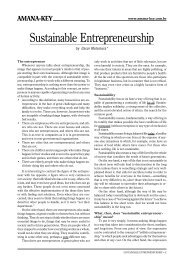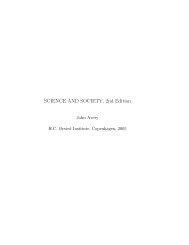Chaordic Organizations - The Pari Center for New Learning
Chaordic Organizations - The Pari Center for New Learning
Chaordic Organizations - The Pari Center for New Learning
Create successful ePaper yourself
Turn your PDF publications into a flip-book with our unique Google optimized e-Paper software.
www.amana-key.com.br<br />
<strong>Chaordic</strong> <strong>Organizations</strong><br />
Oscar Motomura*<br />
How natural are the organizational structures<br />
with which we attempt to order our social<br />
lives Put differently, the question is even<br />
more to the point: how unnatural, artificial,<br />
and <strong>for</strong>ced are these structures To what<br />
degree does this unnaturalness end up significantly<br />
compromising the effectiveness of organizations and<br />
affecting motivation To what degree do our attempts to<br />
“create order” or “guarantee order and prevent chaos”<br />
obstruct the fullest expression of the human spirit<br />
To what degree do mechanical structures (that presuppose<br />
that an organization is a machine and not a living<br />
organism) box people in, fragmenting relations, putting walls<br />
between people, and limiting the actions and the greater<br />
purposes of business and governmental organizations.<br />
To what degree in schools and universities is the development<br />
of children and young people “unnatural” and<br />
below their full potential due to archaic, limited, and ineffective<br />
organizational structures.<br />
In raising these and other similarly fundamental questions<br />
<strong>for</strong> debate in our programs <strong>for</strong> high-level executives<br />
in public and private organizations at Amana-Key, our objective<br />
is to make our participants think, and think profoundly,<br />
going to the heart of these questions, not merely<br />
settling <strong>for</strong> superficial or peripheral answers.<br />
We don’t give recipes in our programs. On the contrary,<br />
our objective is to recover or awaken people’s capacity<br />
to think <strong>for</strong> themselves, to develop custom solutions, to<br />
grow constantly, to look <strong>for</strong> solutions that really work, and<br />
not to become prisoners of simplistic ideas about right and<br />
wrong, in outmoded conceptual frameworks.<br />
In this context, we use the concept of “chaords” with<br />
our executive participants to develop their thinking about<br />
organizational structure and its relationship to the art of<br />
making things happen. We ask our participants to reflect<br />
on their own assumptions over against the principles of<br />
chaordic organizations. We ask them to identify what they<br />
like and what they don’t like, what they would use in their<br />
own organizations and what they would not use, what resistances<br />
their present cultures would have to the concept.<br />
It stimulates a lot of dialogue, a lot of debate, some of<br />
it fairly heated. In these discussions, the assumptions, beliefs,<br />
and “theories” of each participant come to the surface,<br />
without dissimulation. Everyone is thinking…<br />
We have translated Dee Hock’s book, <strong>The</strong> Dawn of the<br />
<strong>Chaordic</strong> Age, into Portuguese, and our participants take<br />
the book and the debate back to their organizations. Given<br />
that our programs on innovation in management reach<br />
roughly 100 high-level executives and 500 middle managers<br />
per month, reaching upwards of 5 to 6 thousand executives<br />
per year from all 27 states in Brazil, no small number<br />
of executives have debated the concept of chaordic<br />
organizations in their respective private enterprises and<br />
government agencies.<br />
In March, 2001, we invited Tom Hurley to speak with<br />
about 300 executives in the annual conference we hold <strong>for</strong><br />
alumni of our flagship program, APG. Tom spoke about<br />
the potential of chaordic organizations <strong>for</strong> the future. <strong>The</strong><br />
receptivity to his ideas was considerable. And we continue<br />
to develop this great debate. No program on innovation<br />
in management can leave out the concept of chaords.<br />
Why are chaordic organizations important today<br />
In our opinion as specialists in management innovation,<br />
organizations must give priority to the concept of the<br />
chaordic organization <strong>for</strong> the following reasons:<br />
1. Scale<br />
Given that we have now reached a world population of<br />
six billion people in a world that is ever more interconnected,<br />
it becomes more and more clear that no mechanical,<br />
top-down organizational structure based on control can be<br />
effective. On this scale, the only effective organizations<br />
imaginable are those that are biological, guided by organizing<br />
principles, and that count on the full potential of people<br />
to think, to create, and to self-organize.<br />
2. Complete democracy<br />
As with nations, so too in companies, the concept of<br />
democracy develops step by step with the evolution of technology.<br />
<strong>Organizations</strong> that are responsible <strong>for</strong> themselves,<br />
societies that are responsible <strong>for</strong> themselves, equality,<br />
an emphasis on cooperation, everyone serving and<br />
everyone served—the concept of chaordic organizations<br />
has everything to do with these ideas. It is a means to<br />
make the ideals of democracy and humanity tangible, <strong>for</strong><br />
the first time in history …<br />
3. Human expression<br />
Mechanical, standardized, and limiting organizational<br />
structures will never succeed in dealing adequately with<br />
questions of human motivation. In principle, there are always<br />
fundamental limitations. <strong>The</strong> most legitimate source of motivation—space<br />
<strong>for</strong> creativity—is always controlled, limited,<br />
and subject to imposed, unnatural standards.<br />
CHAORDIC ORGANIZATIONS • 1
www.amana-key.com.br<br />
<strong>Chaordic</strong> organizations have great potential <strong>for</strong> enabling<br />
human creativity to go beyond its current limits. In fact, if<br />
we don’t contaminate chaordic principles with the fears<br />
inherent in management processes based on control, there<br />
will be no limit to what human beings can create.<br />
4. Essential values, today<br />
Autonomy, freedom, respect – values that people more<br />
and more genuinely value – real freedom, real human respect<br />
are much more in line with chaordic principles than<br />
with the more traditional <strong>for</strong>ms of organizational structure.<br />
In traditional organizations, these values are always<br />
“under pressure,” given little quarter, limited. This occurs<br />
naturally, on the one hand, given that control is, by<br />
definition, the limitation of the space <strong>for</strong> free action. On<br />
the other hand, such values are also limited through abuse<br />
of power, creating “underworlds” in the organization, organizational<br />
politics, unethical agreements, the absence<br />
of transparency, etc.<br />
5. <strong>The</strong> Age of Knowledge<br />
In an age in which all human knowledge will be available<br />
to whomever needs it, it is fundamental that space <strong>for</strong><br />
people be available, that it exist. Not to provide such a<br />
space would be an enormous waste of human potential.<br />
<strong>The</strong> principles of chaordic organizations ensure the<br />
existence of such spaces. Traditional organizational structures<br />
that fragment work in principle limit space, and thereby<br />
reduce the area available <strong>for</strong> action (on the presumption<br />
that its employees don’t have the necessary knowledge,<br />
or sufficient potential to create what is needed). <strong>The</strong><br />
assumption is that their employees are not capable of<br />
thinking, and that they are there to carry out what has<br />
been thought of by others, their “superiors.”<br />
<strong>Chaordic</strong> organizations honor people who think. In fact,<br />
they honor and respect everyone.<br />
<strong>The</strong> potential of chaordic organizations in the<br />
future<br />
Given our work with concepts of chaordic organizations<br />
in our advanced management programs, and in our<br />
work applying these ideas in both public and private organizations,<br />
we see the following challenges ahead:<br />
1. Resistance to the “radicalism” of chaords<br />
In principle, the majority of executives see in the concept<br />
of chaords an enormous amount of good sense and<br />
pragmatism. However, they are also afraid of the inherent<br />
radicalism of the idea, and try to soften the principles by<br />
introducing phrases such as “whenever possible” (instead<br />
of “always”) or “avoid when possible” (instead of “never”).<br />
A big challenge ahead will be to maintain the purity of<br />
the concept, and to be sure that the principles do not become<br />
contaminated with “cautions” typical of the “old system”<br />
based on control. To implement the concept in its<br />
entirety, without alterations or concessions, requires great<br />
courage.<br />
2. <strong>The</strong> capability <strong>for</strong> abstraction<br />
To define principles that truly represent the essence<br />
of an organization requires an exceptional refinement of<br />
the capability <strong>for</strong> abstraction. In addition, those who define<br />
principles must do so in a way that those who are to<br />
implement them (“ordinary” people, regular employees)<br />
will understand them, especially in their spirit even more<br />
than in the letter of the principles.<br />
<strong>The</strong> challenge ahead is going to be to find enough people<br />
in our organizations, as well as in society, capable of<br />
the necessary level of abstraction. Given the type of education<br />
that people in leadership positions tend to receive<br />
(little attention to philosophy, <strong>for</strong> example), the number of<br />
people capable of working with essential principles is not<br />
going to be sufficient. <strong>The</strong> challenge is going to be to trans<strong>for</strong>m<br />
minds trained to deal with procedures into minds<br />
capable of creating principles.<br />
3. Ego and reductionist purposes<br />
<strong>The</strong>re are principles, and there are principles… Some<br />
are aimed at realizing egoic and individualistic purposes,<br />
others are aimed at realizing purposes <strong>for</strong> the common<br />
good, from which everyone benefits.<br />
In a world replete with contradictions, paradoxes, and<br />
imbalances – a world today that is chaotic – the application<br />
of the concept of the chaord requires that we define what<br />
kind of order we want to create. <strong>The</strong> desired order is one<br />
that benefits all, without exception.<br />
And this defines another challenge: lasting, universal<br />
chaords require an advanced level of consciousness. In other<br />
words, a partial chaord, built on a low level of consciousness,<br />
can work, <strong>for</strong> a while. But even in the short term,<br />
anything it succeeds in doing will be shortsighted, illusory,<br />
fleeting, and ultimately will only contribute to the chaos of<br />
the whole rather than to a new and greater order.<br />
4. Universal principles<br />
Ultimately, those principles that serve as the basis<br />
<strong>for</strong> chaordic systems must be universal in character, and,<br />
as such, based on that which is truly universal.<br />
In this sense, the greatest challenge in the future will<br />
continue to be our eternal quest <strong>for</strong> greater truths, in<br />
fact, <strong>for</strong> Truth itself, those great principles that govern<br />
everything around us, the Truth that governs both the<br />
macrocosm and the microcosm. <strong>The</strong> greatest challenge<br />
is <strong>for</strong> everyone together, humanity as a whole, to seek<br />
this great Truth. Science, metaphysics, and all the paths<br />
of knowledge are united in this process.<br />
Only the capability <strong>for</strong> abstraction will enable us to<br />
translate these great principles <strong>for</strong> use in organizations,<br />
companies, nations, and all of society. It is in this coherence<br />
that the order we all seek resides.<br />
2 • CHAORDIC ORGANIZATIONS
www.amana-key.com.br<br />
5. <strong>The</strong> chaord as fad<br />
<strong>The</strong> concept of the chaord must not become fragmented.<br />
Such would be nonsense, a paradox, an oxymoron.<br />
More than a <strong>for</strong>mula, a recipe, a “fad,” chaords must be<br />
seen as a new way of living—freer, more genuine, more<br />
truthful.<br />
This is another great challenge <strong>for</strong> the future: to keep<br />
the mere idea of the chaord from becoming more powerful<br />
than its essence. Because in terms of essences, it is the<br />
ideal of life that we seek that inspires us, and not merely<br />
its appearances.<br />
In our vision, chaos is the fragmented vision of the world.<br />
Humanity has no other recourse than to adapt to the inherent<br />
order of the Universe. We must create ways of life<br />
based on integration and the harmony of all things. This<br />
order is dynamic, in constant evolution, and always realizing<br />
higher levels of consciousness.<br />
In this vision, isn’t the concept of the chaordic an extraordinary<br />
invitation <strong>for</strong> all of us to plunge more deeply<br />
into the creation of this ideal society <strong>for</strong> all Isn’t that the<br />
purpose of life <strong>for</strong> every one of us<br />
*Oscar Motomura is the CEO of the Amana-Key Group, an<br />
international clearinghouse <strong>for</strong> radical innovation in management.<br />
<strong>The</strong> purpose of Amana-Key is to place all its creative<br />
potential in management in service to fostering the highest<br />
level of consciousness in leaders in all areas of activity.<br />
Amana-Key’s intention is to enable conscious leaders to create<br />
together the conditions that ensure a life of dignity and<br />
harmony <strong>for</strong> all.<br />
CHAORDIC ORGANIZATIONS • 3







